Are you ready to embark on your first gardening adventure? Let me be your friendly guide to help you navigate the wonderful world of planting and growing your own garden. Starting a vegetable garden is a great way to enjoy fresh and healthy produce while getting some exercise and spending time outdoors.
Key Takeaways:
- Choosing the right location for your garden is crucial for your plants’ success.
- Start small and grow what you and your family will eat.
- Select easy-to-grow vegetables for beginners, such as beans, lettuce, and spinach.
- Invest in high-quality seeds, learn about garden layout, and provide good soil and water for your plants.
- Remember that gardening is a learning process, and it’s okay to make mistakes and experiment.
Picking the Perfect Location
Picking a good location for your garden is crucial to its success. It is important to choose a spot that receives at least six to eight hours of direct sunlight per day. Vegetables need sunlight to grow and develop properly. The soil should also be well-draining and not stay wet to avoid root rot. Picking a stable location that is not too windy is also important, as strong winds can damage the plants. Understanding the patterns of sunlight in your garden is key for proper plant placement.
The soil should be nutrient-rich, and adding organic matter can help provide the necessary nutrients for healthy plant growth. When selecting the size of the garden, starting small is recommended. A 10′ x 10′ garden is a manageable size for beginners, and it’s important to only grow what you know you and your family will eat. Choosing vegetables that you and your family enjoy eating and are suitable for your climate is also essential.
For smaller spaces, starting with a container garden can offer flexibility in terms of plant movement. Good soil and proper fertilization are essential for healthy plant growth. It is not necessary to own fancy gardening tools, as simple tools like shovels, kitchen scissors, and tape can suffice. Supporting small seed companies and planting what you actually want to eat are important considerations as well. Several online resources like YouTube can provide valuable guidance for gardening techniques and problem-solving.
By keeping these tips in mind, you are sure to pick a perfect location and start your garden off on the right foot. Remember to start small, plant what you’ll consume, and don’t be afraid to seek guidance from online resources. Happy planting!
Starting Small for Success
When it comes to your first garden, starting small is key to ensuring success. It may be tempting to go big right away, but a smaller, manageable garden will be much easier to care for and enjoy. When starting out, there are a few beginner gardening essentials to keep in mind.
First and foremost, picking a good location for your garden is crucial. Vegetables need plenty of direct sunlight, well-draining soil, and protection from strong winds. Start with a manageable garden size, such as a 10′ x 10′ plot in the ground or a 4′ x 4′ or 4′ x 8′ raised bed.
Choose vegetables that you and your family enjoy eating, and consider the availability of vegetables in your area. It’s also important to take care of your plants throughout the growing season, especially during hot summer months. Using high-quality seeds will also help you achieve better yields.
When planning your garden layout, consider either row cropping or intensive cropping, depending on your preferences and space available. Container gardening is also a flexible option for those with limited space. Understanding the patterns of sunlight in your garden area is also crucial, so start small to learn and avoid wasting money.
Investing in good soil and fertilizer, and using basic gardening tools will also help your garden thrive. Support small seed companies when purchasing seeds, and plant vegetables that you actually want to eat and consider your cooking habits. Utilize online resources like YouTube for guidance and troubleshooting along the way.
Remember, starting small and learning as you go is key to a successful first-time garden. Happy planting!
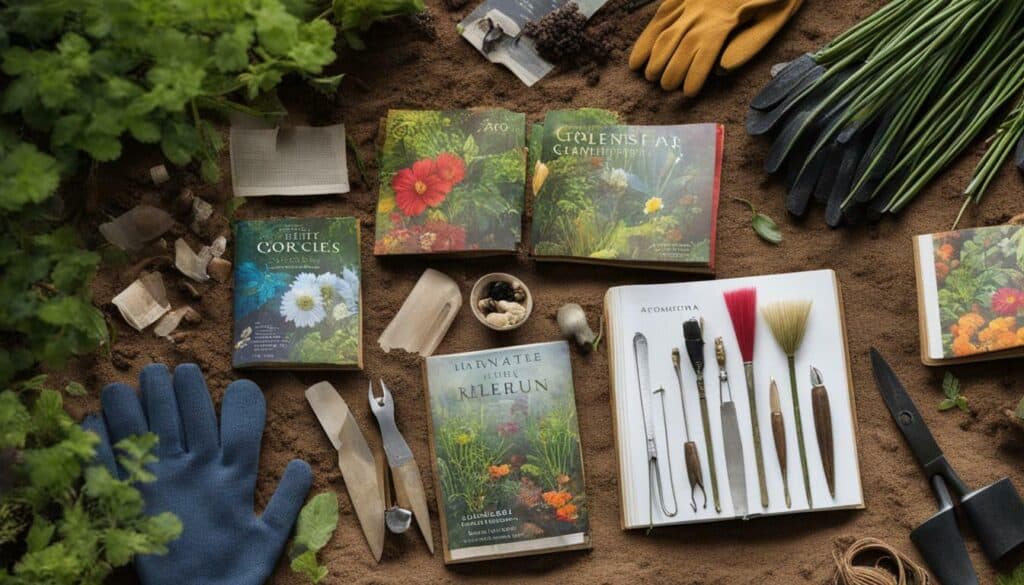
Choosing Easy-to-Grow Vegetables
Choosing the right vegetables for your first garden can make all the difference in your gardening experience. As a beginner, it’s important to start with vegetables that are easy to grow and maintain. This will help boost your confidence and give you a sense of accomplishment when you start seeing the fruits of your labor.
Some of the best vegetables to start with include:
| Vegetable | Why It’s Easy to Grow |
|---|---|
| Lettuce | Grows quickly and can be harvested multiple times throughout the growing season. Can be grown in containers or in the ground. |
| Green beans | Easy to grow from seeds, tolerates a variety of soil conditions, and produces a bountiful harvest. Can be grown on a trellis or along a fence. |
| Radishes | Grows quickly and can be harvested in as little as three weeks. Can be grown in containers or in the ground. |
| Tomatoes | One of the most popular vegetables to grow because they’re delicious and versatile. They do require more attention and care than some other vegetables, but the payoff is worth it. Consider growing cherry tomatoes for a smaller, easier-to-manage plant. |
| Zucchini | Produces a bountiful harvest and requires minimal care. Can take up a lot of space, so consider growing in containers or in a vertical garden. |
| Peppers | Produces a bountiful harvest and is relatively low maintenance. They come in a variety of colors, shapes, and levels of spiciness. |
| Beets | Can be grown in containers or in the ground and produces both edible roots and greens. Tolerates a variety of soil conditions. |
| Carrots | Can be grown in containers or in the ground and produces long, flavorful roots. Requires loose, well-draining soil. |
| Chard | Produces colorful stems and greens that are packed with nutrients. Tolerates a variety of soil conditions. |
| Spinach | Grows quickly and can be harvested multiple times throughout the growing season. Can be grown in containers or in the ground. |
| Kale | Produces large, nutritious leaves that can be used in a variety of dishes. Tolerates cold weather and can be grown in containers or in the ground. |
| Peas | Easy to grow from seeds and produces a sweet, crunchy harvest. Requires support for vertical growth. |
When choosing vegetables for your garden, it’s important to consider what you and your family love to eat. There’s no point in growing vegetables that you won’t enjoy or won’t know how to cook. Additionally, consider the availability of vegetables in your area and what grows well in your climate. Be prepared to take care of your plants throughout the growing season, providing sufficient sunlight and water.
Whether you choose to start small with containers or opt for row cropping or intensive cropping, always remember to use good soil and fertilizer. You don’t need fancy tools to get started; a shovel, hoe, and watering can will do just fine. Supporting small seed companies and planting what you actually want to eat are important factors to consider.
If you have questions along the way, YouTube can be a great resource for gardening advice. Starting a vegetable garden may seem daunting at first, but with the right knowledge and preparation, it can be a rewarding and enjoyable experience.

Considering Your Family’s Needs
Before diving into planting, it’s essential to consider what you and your family enjoy eating and how much you realistically need. When planning your garden, think about the vegetables your family likes to eat and how frequently you consume them. Start with a small garden size that is manageable and expand as you gain experience.
Choosing the right location for your garden is also crucial. Look for a sunny spot with well-drained soil that is protected from strong winds and foot traffic. If you have limited space, consider container gardening as a flexible option.
When selecting vegetables to plant, choose easy-to-grow options like lettuce, green beans, radishes, and tomatoes. Consider the availability of these vegetables at your local grocery store and plant accordingly.
When planning the layout of your garden, you can either use row cropping or intensive cropping. Row cropping involves planting vegetables in rows with space in between, while intensive cropping involves spacing plants closer together in a bed. Good soil and fertilizer are essential for a successful garden, so invest in high-quality soil and choose the right fertilizer for your specific vegetables.
Basic gardening tools like shovels, gardening gloves, and scissors are all you need to get started. Consider supporting small seed companies and planting vegetables that you actually want to eat. Remember to enjoy the gardening process, and don’t be afraid to utilize online resources like YouTube for guidance and advice.
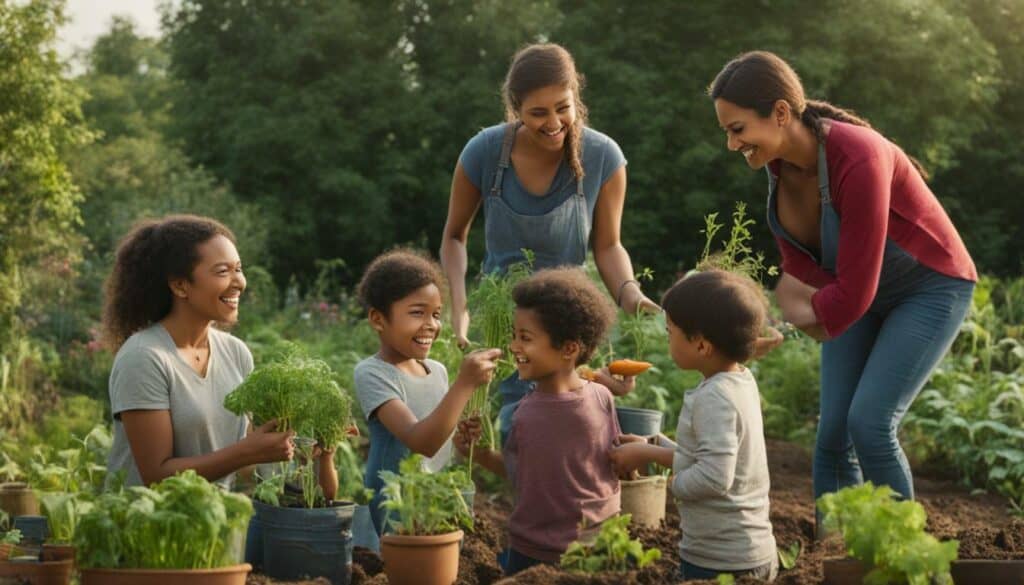
Timing Matters
Timing is everything when it comes to planting your first garden. Choosing the right time to plant cool-season and warm-season vegetables is crucial for a bountiful harvest. Cool-season vegetables, such as broccoli and kale, should be planted in early spring or late summer, while warm-season vegetables, like tomatoes and peppers, should be planted after the last frost of the season.
It’s also important to select a location with ample sunlight for your garden. Most vegetables require 6 to 8 hours of direct sunlight per day, so choose a spot that provides adequate exposure. Additionally, the soil should have good drainage to prevent water from accumulating and causing root rot.
Starting small is often the best strategy for beginner gardeners. Only grow what you know you and your family will eat. Consider the availability of vegetables at your grocery store and be realistic about how much you and your family will consume. By planting both cool-season and warm-season vegetables, you’ll be able to enjoy a continuous harvest throughout the year.
If you have limited space available, container gardening can provide the flexibility you need. Container plants are also easier to move to different locations if needed. Remember to invest in good quality soil and fertilizer, but don’t worry about owning fancy gardening tools; basic ones will suffice.
Supporting small seed companies is an important consideration when selecting seeds. You should also choose vegetables that you and your family enjoy eating. Online resources, such as YouTube, can provide valuable guidance and advice for beginner gardeners.
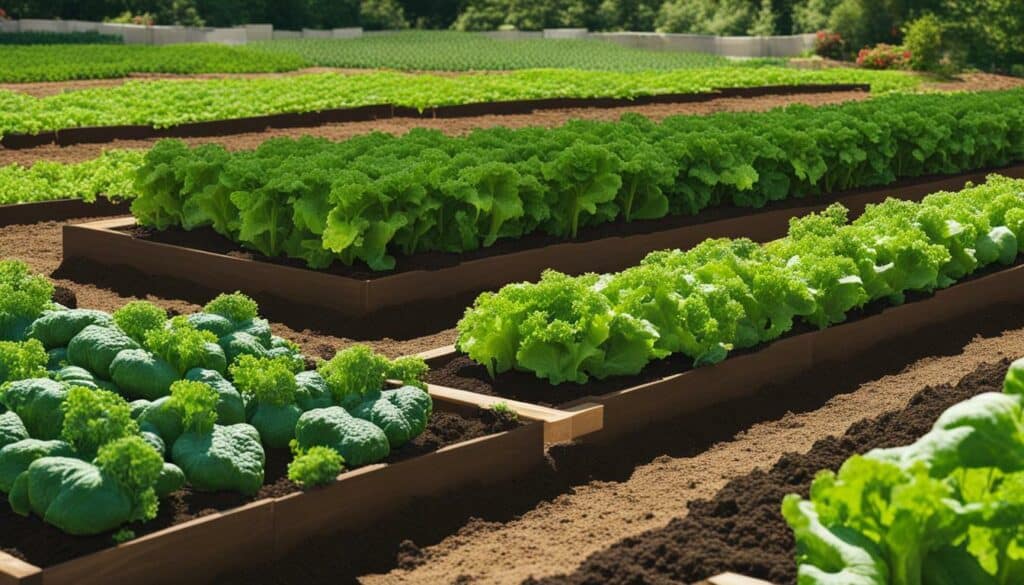
By following these tips, you’ll be on your way to a successful vegetable garden in no time!
Maximizing Sunlight and Space
For a thriving garden, it’s important to ensure your plants receive ample sunlight and make the most of the space you have available. Start by selecting a location that receives six to eight hours of direct sunlight per day. Vegetables need plenty of sunlight to grow and thrive. Additionally, choose a spot that drains well and doesn’t stay wet, as wet soil can lead to rotted roots. Pick a location that’s stable and not too windy, as strong winds can damage young plants and deter pollinators.
Having nutrient-rich soil is also crucial for healthy plant growth. Adding organic matter to thin, nutrient-poor soil can significantly improve its quality. When planning the size of your garden, it’s better to start small and grow what you and your family will actually eat. A 10′ x 10′ garden in the ground or a 4′ x 4′ or 4′ x 8′ raised bed is manageable for beginners.
Choosing the right vegetables is also crucial. Consider what you and your family enjoy eating, as well as the availability of certain vegetables at your grocery store. Start with easy-to-grow vegetables like lettuce, green beans, radishes, tomatoes, zucchini, peppers, beets, carrots, chard, spinach, kale, peas, and herbs.
When it comes to planting, be mindful of the timing. Some vegetables, like lettuce and peas, prefer cooler weather and should be planted in early spring or fall. Others, like tomatoes and peppers, thrive in warm weather and should be planted once the soil has warmed up in late spring or summer.
When it comes to the layout of your garden, consider either row cropping or intensive cropping. Row cropping involves placing plants in single rows with 18 inches of space between them, making maintenance with mechanical equipment easier. Intensive cropping involves planting two to three plants close together in a wider bed, maximizing space utilization.
Finally, it’s essential to start your plants in rich, nutrient-rich soil and use fertilizer as needed. Good soil is worth the investment, as it provides the necessary nutrients for healthy plant growth. Additionally, make sure to label your plants and use the appropriate tools for gardening. If you’re new to gardening, YouTube can be a valuable resource for tips and techniques. Ultimately, plant what you enjoy eating and have fun exploring the world of vegetable gardening while maximizing sunlight and space.
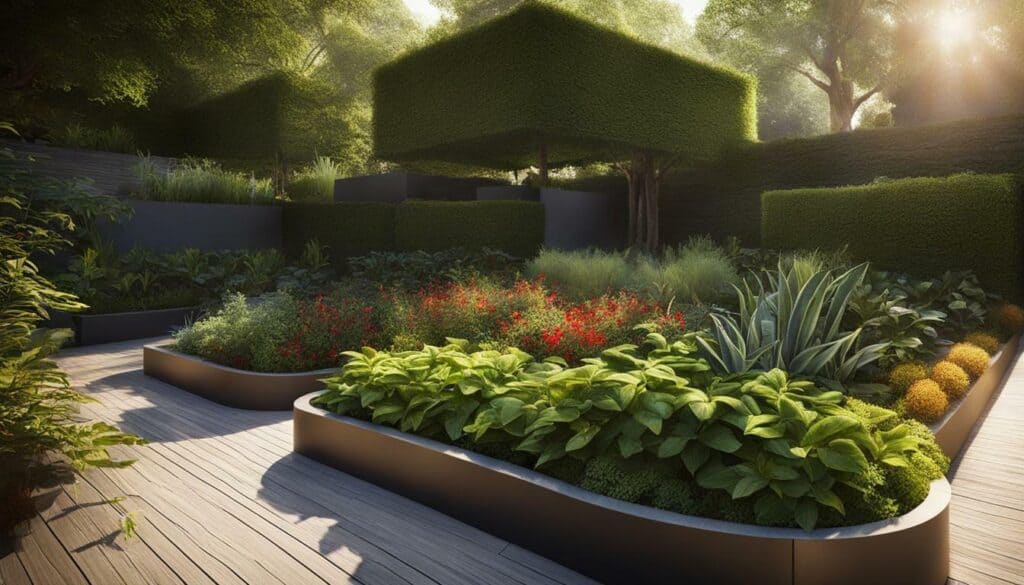
Learning Garden Layout
Understanding your garden space and planning an effective layout is essential for a successful garden. To determine the most efficient layout, you need to consider your available space, sunlight exposure, and the needs of your plants.
One approach is to use the row-cropping method, which involves planting vegetables in parallel rows. This method works well for larger spaces and crops that require a lot of space, such as corn, cucumbers, and beans. Another method is intensive cropping, where plants are placed closer together and no space is wasted. This method is perfect for small gardens and can yield tremendous results in limited space.
When creating your garden layout, be sure to consider the different heights and sizes of your plants. You may want to consider planting taller plants in the back so they don’t shade smaller plants. It’s also important to know the sun’s trajectory in your yard, so you can place taller plants where they won’t cast shadows on others.
Utilizing small spaces and containers can also be a great way to maximize your garden’s productivity. You can plant herbs, tomatoes, and peppers in individual containers, allowing you to move them around to optimize sunlight exposure. Hanging baskets for strawberries and small trellises for climbing vegetables like cucumbers and peas are also effective solutions for limited space.

Remember, gardening is a continuous learning experience, and it’s okay to make mistakes. Start small, experiment, and learn from your experiences. Investing in good quality soil and fertilizer can also greatly improve your garden’s yield. Don’t forget to support small seed companies and choose seeds based on your preferences and consumption needs.
When in doubt, online resources such as YouTube and gardening forums can provide helpful advice and new techniques to try. And most importantly, enjoy the process of growing your own garden!
Investing in Quality and Learning
As a first-time gardener, it’s crucial to start small, invest in good quality soil, and never stop learning. Starting with a manageable garden size will help you avoid getting overwhelmed and provide a better understanding of the care required for your plants.
One of the most important investments you can make for your garden is quality soil. Enriching your soil with organic matter will provide essential nutrients and promote healthy plant growth. Investing in good soil and fertilizer will ensure that your vegetables have the best possible growing conditions and yield a bountiful harvest.
| Tip: | Check with your local gardening center for recommendations on soil and fertilizer tailored to your region and the plants you intend to grow. |
|---|
While fancy gardening tools are not necessary, starting with high-quality seeds can make a significant difference in your garden’s success. It’s recommended to choose seeds based on your preferences and cooking habits and to support small seed companies whenever possible. Additionally, planting at the appropriate time based on temperature preferences and utilizing containers for gardening can provide flexibility in optimizing plant placement and understanding your gardening space’s sunlight patterns.
Learning from experiences is a vital aspect of vegetable gardening. YouTube can be a valuable resource for learning gardening techniques and troubleshooting issues. It’s important to stay curious and experiment with different vegetables and techniques to see what works best for you.
Focusing on practicality in your garden choices will lead to a fulfilling and successful vegetable gardening experience. Consider the availability of vegetables at your local grocery store and your family’s preferences when planning your garden. Ultimately, planting vegetables that you genuinely enjoy eating will bring you the most satisfaction.
Choosing the Right Seeds
When it comes to choosing seeds for your first garden, there are a few key considerations to keep in mind. Firstly, it is important to support small seed companies. These companies often offer organic and heirloom seeds, which can be better suited to your local climate and soil conditions. Secondly, choose seeds based on your personal preferences and cooking habits. There’s no point growing a vegetable that you don’t like or won’t use.
It’s also important to be realistic about how much you can consume and the availability of vegetables in your local grocery store. Starting with easy-to-grow options such as lettuce, green beans, radishes, tomatoes, zucchini, peppers, beets, carrots, chard, spinach, kale, and peas is recommended. Pick vegetables that you and your family enjoy eating and that grow well in your local climate.
Healthy plant growth begins with nutrient-rich soil, so be sure to add organic matter to your soil. Additionally, take care of your plants throughout the growing season by ensuring they receive adequate sunlight and water. If you plan to be away during the summer, make arrangements for someone to care for your plants. While fancy gardening tools are not necessary, investing in good quality soil and appropriate fertilizers is recommended.
Starting small is also important, as it allows you to learn and gain confidence as a gardener. Finally, remember that YouTube can be a great resource for finding gardening advice and guidance. Embrace online resources and enjoy the journey of growing your own delicious vegetables.
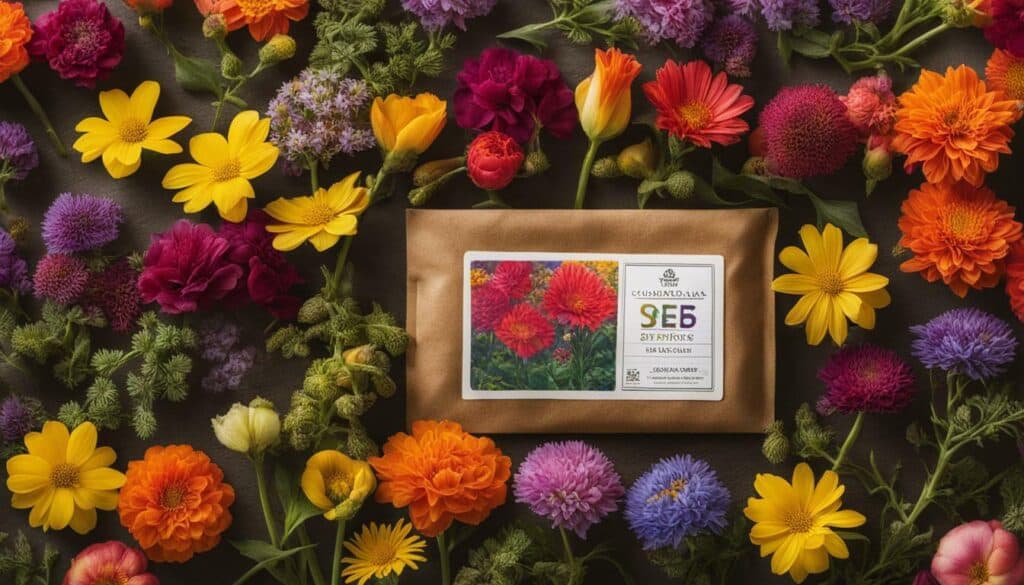
Embracing Online Resources and Enjoying the Journey
In today’s digital age, there are abundant online resources available to assist you on your gardening journey. From growing vegetables to maintaining a garden, there are numerous guides and forums that provide helpful tips and advice. Utilizing these resources can greatly enhance the experience of starting a vegetable garden and provide a wealth of knowledge that can be applied to your gardening journey.
Online guides provide comprehensive information on topics such as how to start a garden from scratch, what vegetables to grow, and when to plant them. These resources offer valuable tips on picking the right location for your garden, selecting the right size, and choosing the best vegetables for beginners. Additionally, they recommend starting small and growing what you love to eat.
Online sources also provide information on the importance of sunlight and water access, as well as tips on planning your garden layout. Furthermore, they offer advice on soil preparation, the benefits of container gardening, and the use of good quality soil and fertilizer.
Moreover, online communities and platforms like YouTube can prove to be valuable sources of knowledge and guidance for beginner gardeners. Online tutorials offer visual demonstrations of key gardening techniques such as planting, watering, and pruning. Additionally, online communities provide opportunities for gardeners to share their experiences and learn from others.
Embracing these online resources can help gardeners enjoy the journey of growing their own food. Learning from online guides and communities, experimenting with different techniques, and sharing your experiences with others can be a fulfilling and rewarding experience. So, dive into the world of online gardening resources and enjoy the journey!

Conclusion
Congratulations on taking the first step towards planting your own garden! Remember to be patient, learn from your experiences, and most importantly, enjoy the process of growing your own garden.
Starting a vegetable garden can be a rewarding and cost-effective way to enjoy fresh produce. It is important to choose the right location for your garden, ensuring it receives ample sunlight and has well-drained soil. Starting small is recommended for beginners, selecting a few favorite vegetables to grow. It is also important to consider what you and your family enjoy eating and how much you can realistically consume.
Planning your garden layout and understanding the needs of different plants is crucial for successful gardening. Container gardening provides flexibility and allows for easy movement of plants. It is advisable to use good-quality soil and fertilize accordingly. While fancy tools are not necessary, basic gardening tools and equipment can be helpful.
Supporting small seed companies and planting what you actually want to eat is important. Additionally, taking advantage of online resources such as YouTube can provide valuable guidance and advice.
So, get out there and start planting! With the right mindset and a little effort, you’ll be enjoying the fruits of your labor in no time.
FAQ
Q: What are some tips for picking a good location for my garden?
A: Choose a sunny spot with well-drained soil and minimal wind or foot traffic.
Q: How big should my first garden be?
A: Start small with a manageable garden size, such as a 10′ x 10′ plot or a 4′ x 4′ raised bed.
Q: What are some easy-to-grow vegetables for beginners?
A: Consider lettuce, green beans, radishes, tomatoes (by transplant), zucchini, peppers (by transplant), beets, carrots, chard, spinach, kale, and peas.
Q: How do I know how much to plant?
A: Consider what you and your family like to eat and how much you will realistically consume. Don’t overplant.
Q: When should I plant different types of vegetables?
A: Plant cool-season vegetables in early spring and warm-season vegetables in late spring or summer.
Q: How can I maximize sunlight in my garden?
A: Ensure your garden receives ample sunlight, at least 6 to 8 hours per day. If you have partial shade, choose vegetables and herbs that tolerate those conditions.
Q: How can I start gardening with limited space?
A: Start with a small space or use containers, which offer flexibility and the ability to move plants as needed.
Q: How should I plan the layout of my garden?
A: Understand your space and the patterns of sunlight to plan your garden layout effectively.
Q: What should I invest in for my garden?
A: Start small, take time to learn, and invest in good quality soil and appropriate fertilizers.
Q: How should I choose the right seeds for my garden?
A: Support small seed companies and choose seeds based on your preferences and cooking habits.
Q: Are there any online resources I can use for gardening tips?
A: Utilize online resources like YouTube for gardening tips and guidance.
Q: What is the key to successful gardening?
A: Be patient, learn from your experiences, and enjoy the process of growing your own garden.
Why is Starting a Garden Considered the Beginning of Time?
The time’s origin in a garden discovery has been revered for its symbolic significance and metaphoric resemblance to new beginnings. Starting a garden is often seen as an act of reconnecting with nature and embracing the cycle of life. It symbolizes the birth of plants, the growth of seedlings, and the transformation that occurs over time. Additionally, tending to a garden allows individuals to cultivate patience and appreciate the beauty of slow but continuous progress. Ultimately, a garden serves as a tangible reminder of the eternal connection between humans and the natural world.
Source Links
- https://www.almanac.com/vegetable-gardening-for-beginners
- https://food52.com/blog/26124-how-to-start-a-vegetable-garden
- https://www.bhg.com/gardening/vegetable/vegetables/planning-your-first-vegetable-garden/
- https://gardenerspath.com/how-to/beginners/first-vegetable-garden/
- https://sebsnjaesnews.rutgers.edu/2020/04/choosing-the-right-location-for-your-vegetable-garden/
- https://www.gardensthatmatter.com/choose-garden-location/
- https://www.bhg.com/gardening/yard/garden-care/ten-steps-to-beginning-a-garden/
- https://frugalfamilyhome.com/home/gardening/how-to-start-a-vegetable-garden-from-scratch
- https://www.almanac.com/content/10-easy-vegetables-grow-seed
- https://shiftingroots.com/10-easy-vegetables/
- https://www.gardenary.com/blog/is-it-too-late-to-start-a-garden
- https://hort.extension.wisc.edu/articles/beginning-vegetable-garden-basics-site-selection-and-soil-preparation/
- https://www.democratandchronicle.com/story/lifestyle/2020/04/19/how-much-sunlight-your-garden-need-depends-what-you-plant/2970473001/
- https://www.gardeners.com/how-to/vegetable-gardening/5069.html
- https://commonsensehome.com/start-a-garden/
- https://www.growforagecookferment.com/how-to-choose-the-right-seeds-for-your-garden/
- https://www.forbes.com/sites/nomanazish/2022/08/31/how-to-choose-the-best-seeds-for-your-vegetable-garden-according-to-gardening-pros/?sh=24ad645e34ef
- https://journeywithjill.net/start-here/
- https://chestnutherbs.com/medicinal-herb-gardening-for-beginners/
- http://lizfabry.blogspot.com/2012/11/garden-update.html?m=1
- https://www.preciouscore.com/7-life-lessons-i-have-learned-from-my-first-garden/





Leave a Reply